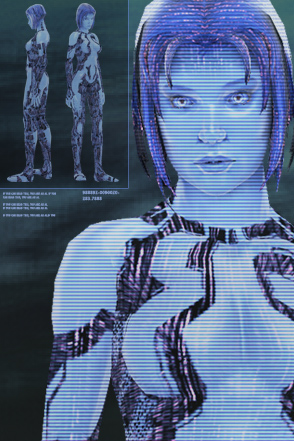 In real life, the term “hologram” means something fairly specific. But in science fiction, it can mean a number of different things.
In real life, the term “hologram” means something fairly specific. But in science fiction, it can mean a number of different things.
For example, in Star Wars it’s basically a three dimensional video recording projected on a flat surface. In Halo, it’s the visual form that the AI character Cortana takes when she wants to interact with the Master Chief. And in Star Trek, the holograms actually have a degree of physical substance, so that in some episodes they go rogue and try to take over the ship.
The basic underlying idea, though, is the same: blurring the line between the virtual world and the real world through a virtual projection that we can interact with. And in that sense, this is actually an area where science fact is fast catching up with science fiction.
Some sub-genres, such as cyberpunk, focus almost solely on the tension between the real and the virtual. Often set in a near-future world, cyberpunk stories often feature a crapsack future, from which the only meaningful escape is a virtual reality. But the thing about virtual realities is that they can be reprogrammed in such a way as to give the ones controlling it almost absolute power over the lives of the people inside. For that reason, the main characters are often hackers, struggling against the corporate evil overlords.
But holograms aren’t restricted to cyberpunk. They’re quite common in space opera, too, and not just because they’re cool. For one thing, they can be really useful for training simulations (which often leads to holodeck malfunctions, courtesy of the rule of drama). They can also be useful as disguises or decoys, especially in the Halo series.
But perhaps the most memorable holograms are the ones who develop a close relationship with their real-world human counterparts. This may include romance, which, combined with the existential angst that typically surrounds androids, robots, and cyborgs, makes for some very interesting tension. A good example of this is Cortana from the Halo series, an alien AI who took on a younger form of her human handler, Doctor Halsey, and then developed a very close relationship with her Spartan bodyguard, the Master Chief. It never actually went anywhere (at least in the main series arc), but it certainly made for an interesting story.
Jane from the Ender’s Game series would probably be my favorite hologram, though she’s more of a shapeshifting AI who can take many different forms, depending on what suits her. Cortana is definitely up there too. I haven’t used this trope much in my own fiction yet, but I’m playing with it in Heart of the Nebula, a currently unpublished direct sequel to Bringing Stella Home. Not sure exactly where I want to take it yet, but it should be interesting.

Awesome post! I’ll be back to read more. I’m glad I found your blog on the A-Z Challenge!
Holograms in real life are pretty amazing. I saw a holographic show once, brilliant!
Haven’t played with them in sci-fi, but they do have a lot of potential.
Rinelle Grey
Thanks guys! Glad you enjoyed it.